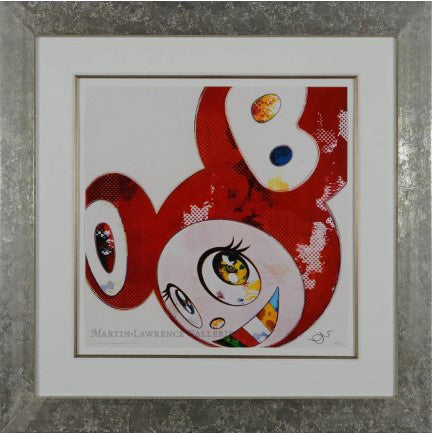
Takashi Murakami (b. 1962) is one of the most influential artists of his generation, an artist-entrepreneur whose studio system, scholarship, and showmanship re-framed how contemporary art engages with popular culture and Japanese visual history. Educated in Nihonga (traditional Japanese painting) at Tokyo University of the Arts, where he earned a PhD in 1993, Murakami fused that training with anime/otaku aesthetics to formulate Superflat, a term and curatorial project he launched around 2000 to argue for a continuum between pre-modern Japanese picture-making and postwar mass culture.
Murakami’s museum career has unfolded through landmark surveys that also tested the boundaries of art and commerce. His first full retrospective, “©MURAKAMI,” traveled to MOCA Los Angeles, the Brooklyn Museum, MMK Frankfurt, and the Guggenheim Bilbao (2007–09), and famously incorporated a functioning Louis Vuitton boutique as part of the installation. In 2017–18, “Takashi Murakami: Lineage of Eccentrics” at the Museum of Fine Arts, Boston, staged his canvases and sculptures alongside historic Japanese masterpieces to make explicit his dialogue with Edo- and Rinpa-period art, developed in collaboration with art historian Nobuo Tsuji. His 2022–25 exhibition “Stepping on the Tail of a Rainbow,” initiated at The Broad in Los Angeles and expanded in 2025 at the Cleveland Museum of Art, emphasized how exuberant color and cuteness sit atop deeper meditations on trauma, recovery, and cultural memory.
At the center of Murakami’s practice is Kaikai Kiki Co., Ltd., his production company and publishing arm, which embodies his belief that art-making should be as much about infrastructure as inspiration. Echoing the collaborative ateliers of Japan’s pre-modern masters, Kaikai Kiki supports not only his monumental canvases and sculptures but also a prolific program of editioned works.
Murakami describes his practice as a constant toggling between Japan’s classical forms and contemporary life. In a recent artist statement he likened his method to “backcrossing,” selectively breeding new generations from parent lines—an apt metaphor for the way Rokuyō schools, Rinpa patterning, Buddhist icons, and manga DNA recombine on his surfaces. Interviews in Japanese underscore a pragmatic ethos: “art is a means of living,” he has said, while insisting on the capacity of painting to create enduring cultural experiences even in a digital era.
Today, Murakami stands as both a cultural icon and a shrewd builder of value. His prints and multiples are not ancillary to his career but integral to it: a space where technical innovation, philosophical ideas, and market sensibility converge. For collectors, acquiring his editions means more than owning an image—it means holding a piece of one of the most ambitious and globally significant artistic projects of our time.







